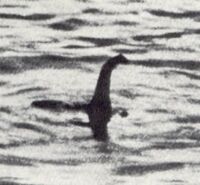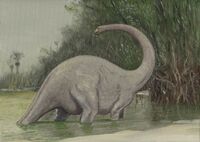
The famous "Surgeon's Photograph", depicting the famous Loch Ness Monster, an example of a cryptid.
Despite their extinction, monsters and unidentified animals have been witnessed by countless people, many of which are commonly compared to prehistoric animals. Among the most popular are resemble animals from the Mesozoic and Cenozoic era.
Many dinosaur sightings take the form of photographs, amateur video footage, eye-witness accounts or folklore. Most reports of living dinosaurs or prehistoric animals are immediately rejected or debunked, however some sightings receive media attention and thus causes some people to believe that the extinct clade of animals may still exist. Some animals have even been rediscovered as extant creatures from these sightings.
Examples of Dinosaurian Cryptids[]
- The Arica Monster is a cryptid apparently living in Arica, Chile. Some cryptozoologists have suggested that the creature is a dromaeosaurid or ornithomimid.
- Burrunjor is a large lizard which has been sighted throughout New South Wales, Arnhem Land and Cape York Peninsula. Some people have suggested that it is some sort of theropod dinosaur, a perentie, or a surviving Megalania.
- The Emela-ntouka is a large cryptid which, according to African mythology, lives in Central Africa. It is the size of an African bush elephant, possesses a large, keratin horn, a short, stocky body and is semi-aquatic. Some cryptozoologists have suggested that the Emela-ntouka is a ceratopsian such as Centrosaurus or Monoclonius (even though there is no record of African ceratopsians) or even a type of semi-aquatic rhinoceros.
- Mbielu-Mbielu-Mbielu is supposedly a dinosaur-like creature living in the Republic of the Congo. It is herbivorous, aquatic and has thick algae growing on its back (which witnesses call "planks"). The most common dinosaur attributed to this creature would be the Kentrosaurus.

An artist's impression of Mokèlé-mbèmbé as a sauropod dinosaur.
- Mokèlé-mbèmbé, one of the most famous cryptids, is a large, water-dwelling creature which lives in the Congo River basin, according to local folklore. There have many sightings of the cryptids and many expeditions searching for it - all of which being unsuccessful. Many cryptozoologists believe that Mokèlé-mbèmbé is a sauropod (like Brontosaurus, Apatosaurus, Diplodocus, or Amargasaurus), a Megalania, or a Paraceratherium.
- Muhuru is a Stegosaurus-like cryptid apparently living in Kenya. According to local legend, it possesses a thick body armour, large back plates and a tail club. Many people believe that Muhuru is a possible descendant of Stegosaurus. However, no stegosaur ever had body armour or a tail club.
- Mbielu-mbielu-mbielu is a semiaquatic cryptid similar to Muhuru, but appearing in The Republic of Congo's Likouala region. Like its Kenyan counterpart, it is a large herbivorous animal with large "planks" on its back. Many sightings have been in or near water, so a terrestrial creature is out of the question. The top contenders for the source of the sightings are large crocodilians or a surviving stegosaur. The only similarity to stegosaurs are the plates on its back, but there is no mention of any other similarities; crocodilians are the leading hypothesis.
- Ngoubou is an ceratopsian-like animal reportedly living in the savanna region of Cameroon. According to local pygmy tribes, the creature possesses six horns, often battles elephants for territory, despite only being the size of an ox. William Gibbons identified the animal as a Styracosaurus, even though the dinosaur genus only existed in North America.
- Nguma-monene is, according to African village folklore, a large lizard-like animal with a serrated ridge running down its back. Some cryptozoologists have suggested that the creature, if predatory, may be a Suchomimus, Spinosaurus, or even a Dimetrodon; descriptions could also fit some stegosaurs, ankylosaurs, or even a smaller species related to Amargasaurus.
- The Sirrush is a draconic creature depicted in Babylonian art. Painted living alongside animals such as the lion and the aurochs, many people believe that the Sirrush is an Iguanodon.
- The Lake Murray Monster has been sighted in the Lake Murray in Papua, New Guinea. It is thought to be a tyrannosaur according to the public. It is told that some people have also been attacked from it.
Examples of Non-Dinosaurian Cryptids[]
- Bigfoot, or Sasquatch, is a large, bipedal, human-like ape which apparently exists in the Pacific North-west region of North America. It is a popular cryptid and it has been the focus of many hoaxes. Some people believe Bigfoot to be a descendant of the large prehistoric ape Gigantopithecus or possibly an undiscovered hominid. There are many variants of this creature found across the world including the Skunk Ape, Grassman, and Momo.
- Champ is a large, aquatic creature apparently living in Lake Champlain, a lake in North America. There have been many explanations for this creature's existence, with some cryptozoologists labeling it as a plesiosaur, a Basilosaurus and even a Tanystropheus.
- The Loch Ness Monster, also known as Nessie, is a plesiosaur-like creature reportedly living in Loch Ness, a freshwater loch located in the Scottish Highlands. It is one of the most well-known and sighted cryptids alongside Bigfoot. Many cryptozoologists hypothesize if the creature exists, it could be a surviving plesiosaur, basilosaur, or even sauropod in the lakes of Scotland. While many believe in the creature, the animal has had a history of hoaxes in the last - the most famous of which being the Surgeon's Photo (seen at top of page). When Robert Wilson took the picture, he didn't confess the object was not only smaller than expected but also a small tin boat with a neck; after this was discovered, the photo was deemed a hoax but is still used as an icon of not only Nessie but cryptozoology itself.
- There have been many pterosaur sightings, particularly in North America. Many images have emerged showing living or dead pterosaurs, particularly genera such as Pteranodon and Rhamphorhynchus.
- Thylacinus cynocephalus, or the Tasmanian tiger, is often considered a cryptid, due to multiple sightings in Australia and nearby islands. It went extinct relatively recent from human hunting and invasive species, with the last specimen captured in 1930. Due to the vast stretches of undiscovered wilderness across the continent, many consider a high possibility a few have survived.
- The Yeti is a humanoid ape-like creature reportedly living in the Himalayas. Like Bigfoot, it is bipedal, resembles a hairy ape and has often been attributed to Gigantopithecus.
- There have been sightings of the famous shark Megalodon in the coastal parts of Mexico. The fishermen of the coasts there report that "a 100 foot long shark" is living and reported to eat citizens there. Megalodon have been sighted daily for some days in The Mariana Trench. Most witnesses have estimated the creature to be close to 65 feet.
- The Thunderbird is a large bird mentioned in Native American culture, with many believers in it today. Legends have described its wing flaps to cause storms (hence the name) and even steal whales from the ocean to take to their nests. Possible extinct animals this could be mislabeled as the extinct Argentavis.
- The giant anaconda might be the extinct Titanoboa.
- Zuiyo-maru carcass might be a dead plesiosaur.
- Mapinguari is possibly the extinct giant ground sloth.